So says Stephen Fry, the narrator for all of the popular Harry Potter films, about 800 seconds into the new 59-minute movie, "The Machine That Made Us" (Wavelength Films Ltd.). You can download the entire 100-Megabyte movie that aired earlier this year on BBC Four television at DontPressMe.com's site (I'd recommend you begin downloading it now in another window to get a headstart on it; after the page loads, press the viewer's Pause button, & resume reading this blog while it continues to download). It's well worthwhile for anyone interested in the history of the Bible.
Gutenberg didn't really "invent" the press; his chief accomplishment was his streamlining of the entire book-manufacturing process, bringing together movable/recyclable type, paper (from recycled rags), ink, press, & binding. His goal wasn't simply to mass-produce books, so much as to mechanically replicate handmade books. For example, instead of making a single uppercase "G", & a single lowercase "g", he formed about half-a-dozen variants to create what could legitimately be named Artificial Writing, & contemporaries spoke of his trade as the "art of multiplying books".
I've studied Gutenberg a bit, & have seen 2 original Gutenberg Bibles (The Huntington Library's vellum copy, & the Library of Congress (LOC)'s paper copy), several individual leaves ... usually in exhibits behind security glass except one I was allowed the privilege of holding for a few seconds (by a dealer/acquaintance, Dr. Craig Lampe; currently offering 2 for $79k & $119k). I also own 19 facsimile leaves (worth a whopping $19(!); discussed in the book I began writing in the late 1990s prior to becoming involved in LMLK research). Nonetheless, I found this film informative &, to a certain degree, entertaining. I especially liked Fry's observation that Gutenberg's press probably resembled that of a winepress used for squeezing grapes to make wine (another LMLK tie-in).
It was brought to my attention by Kitty Maryatt, Director of the Scripps College Press, Assistant Professor of Art at Scripps, and proprietor of Two Hands Press in Playa Vista, CA. She's been involved in the book arts since 1971 as a calligrapher, book artist, letterpress printer, binder, & teacher. Students in her Scripps class, "Typography and the Book Arts", have developed, written, printed, & bound 42 different editions. As Two Hands Press, she produces work for clients and makes her own one-of-a-kind books. Her credentials & her eloquence are very impressive (pun intended)!
She gave an excellent 1-hour lecture this weekend at The International Printing Museum, located a mere 15-minute drive from where I live here in southern California. I've been a financial supporter of this tremendous institution for over a decade now, & if you're ever visiting the region, I'd highly recommend you center your agenda around it!
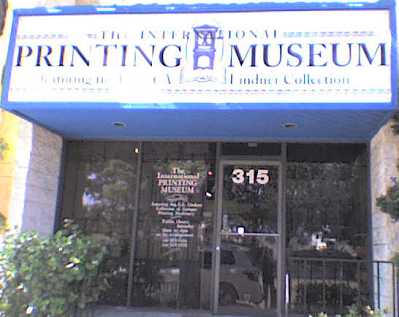
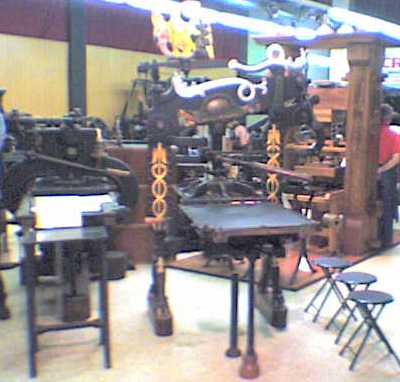
Mark Barbour, the Director & Curator, & his docents always make it an entertaining, hands-on learning experience covering the entire history of printing, from cuneiform clay tablets, to Chinese paper-making, to Gutenberg's press (one of the few places in the world where you can see a working replica of one), to the history of printing in America. In particular, with the help of one docent who dresses up as Benjamin Franklin when school children visit on field trips, they emphasize the Revolution era & the Constitutional Convention (the kids get to play politicians from the 12 colonies [noting Rhode Island's absence]).
You can even get an authentic line-of-type cast from molten metal with your name (or any respectable words):
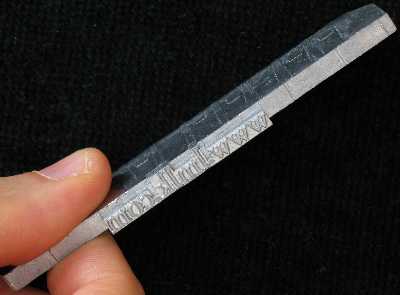
So how do all these topics, a Gutenberg movie, the American Revolution, & a chunk of metal, relate?
Prof. Maryatt's lecture discussed a project she challenged her students with a couple of years ago. Each year they produce their own original book, & in her lecture, she described one involving the replication of an original Gutenberg leaf kept in the Special Collections department of the Scripps College libraries (which are adjacent to, but distinct from, the Claremont School of Theology where I did a significant chunk of my LMLK research).
Here's the ad & abstract for her lecture, "Emulating Gutenberg with B-42 Type":
"This lecture is sponsored by a generous grant for the Book Club of California. Founded in 1912, The Book Club is a non-profit organization of book lovers and collectors who have a special interest in Pacific Coast history, literature, and fine printing. Its chief aims are to further the interests of book collectors and scholars and to promote an understanding and appreciation of fine books.
Ms. Maryatt will discuss her fascinating experiences hand setting a facsimile page of the Gutenberg Bible using Dale Guild Type Foundry’s B-42 type, a faithful re-cutting of the types of Johann Gutenberg, as seen in his monumental 42-line Bibla Sacra, ca. 1455. Production of this font required that 245 characters were drawn, cut and cast.
The Scripps College Press developed an artists' book version of a leaf book. The resulting letterpress edition was called Beorum II, an investigation of risk.
In her lecture, Ms. Maryatt provides an explanation of scribal practices used in medieval books to enhance an understanding of the abbreviations and ligatures in the font. She will also provide information and elaboration related to the printing press, the handmade paper and vellum used for the edition, the decoration and aspects of medieval bookbinding practices and bookselling.
In addition to the lecture and PowerPoint presentation, attendees will have opportunities to see one of the printed pages and see some pieces of the Gutenberg type."
By the way, to inspire comments for this blog, I'd like to encourage my readers to guess why her students titled their book, "Beorum II"!
So while she & her students were busy producing their book in California, Stephen Fry was busy making his film in Europe. About 800 seconds into the film, I noticed a red flag in his research while he was in the basement of The British Library & stated, "They hold a copy of every book published in English!"
That may just be a little of his British pride peeping through his script, because all librarians know that our beloved LOC (founded on the great Thomas Jefferson's collection) has more books (20 to 30 million) than any other library in the history of the world has ever had, including a copy of my LMLK vol. 1, which is also in Harvard University's research library, but not in the British Library (which only has a paltry 13 million ... about half of LOC's)!
(Note to any librarian of the British Library reading my blog ... publicly admit that the LOC's books outnumber your own, & I'll send you a free copy of Lv1 to help your institution's card catalog evolve!)
During her lecture, Prof. Maryatt mentioned the movie was a documentary in which they were attempting to teach Gutenberg's achievement by building their own version of his press in order to reprint a page of his Latin Bible. They successfully built the press & made some rag-paper, but they lacked the letter-type that Scripps College had invested in (I think she said it cost in excess of $5,000).
I did not bring my high-quality camera along with me, but when I saw the actual type after her lecture, I found it so mesmerizing that I had to go out to my car & retrieve my cellphone, & use its built-in low-quality camera to take a picture of it. Even though the photo turned out fuzzy, I thought it would be nice to include it here since I don't usually include photos in most of my blogs:
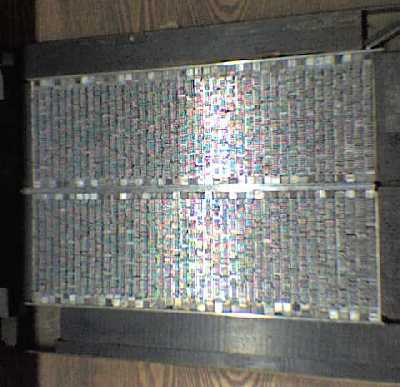
I suppose that what fascinated me the most was imagining what it would've been like to see the original type some 550 years ago, the first time it had been arranged in the case like this, awaiting to print the first page of a Holy Bible!
When she showed one of the pages printed & hand-illuminated by her students side-by-side with a Xerox-copy of the original leaf, it was truly amazing! Gutenberg had printed his on slightly moist paper, or in a very humid environment, because the pressing operation caused some of the letters to bleed ink, resulting in a slightly smudgy appearance under high magnification. In fact, in one letter she zoomed in on during her slideshow, you could clearly see the outline of the original type within the puddle of ink since it was a shallower puddle of ink than the adjacent area it bled into. So side-by-side, the letters printed by her students were crystal clear:
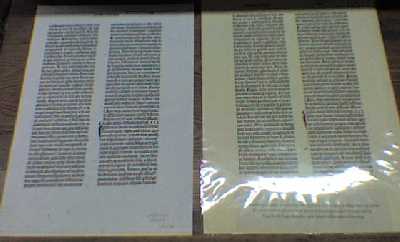
It was a remarkable achievement, because not only did they have to identify the numerous versions of letters that Gutenberg originally cast (at least 270 variants identified by one researcher), but they also had to justify the columns & add filler material between the letters to maintain the same spacing!
46 minutes into the film, after outlining Gutenberg's history, his culture, & replicating a wooden press, & manufacturing a piece of paper & a single piece of type (a lowercase "e"), Stephen Fry brings us to the film's climax:
"The great day's arrived! It's been 5 months since Alan [May] first got together his plans & designed his printing press. It's now built, type has been made in Basel, I've cast the type personally, nothing can stop us from printing a page of Gutenberg text! This must be how the great man felt, himself! [begin voice-over] Before we start printing, I have a little confession to make: It took Stan [Nelson] & me the best part of a day to make just one individual letter, 'e'. To produce all the type needed to print a full Bible, probably took Gutenberg's team around a year, & frankly I don't have his time or his patience, so I cheated. This package has come from the States. It's a replica page of type set to the exact measurements of a Gutenberg original, & thankfully, nothing's been damaged in transit. [end voice-over] So this is ... [shakes his head in awestruck disbelief after opening the package sent by Prof. Maryatt of Scripps College] ... so this is perfect, isn't it?! We can print from these?!"
Well, you can watch the film to see for yourself if Fry & his team were successful in printing a Gutenberg leaf the old-fashioned way (not the way my 19 facsimiles were printed using photolithography); however, one thing you won't learn from the film, even from the credits that run during the final minute, is who made the type & loaned it to them! Those words crediting those persons are completely missing! I WAS SHOCKED! Those ungrateful British rats!!! They didn't mention Scripps College, Kitty Maryatt, or her students ... they didn't even mention California!
It's as if, "We were up against a dead end, & all we could print was one stupid letter made in Europe, then lo & behold, out of nowhere, a miracle happened, & this humble package came knocking on our door at just the right time, with all the letters from an original leaf of the Gutenberg Bible meticulously manufactured & arranged like they were 550 years ago ... wow, aren't we a lucky bunch of chaps, yes we are indeed..."
Shame on you Stephen Fry!
Shame on you Wavelength Films Ltd.!
So I'm deliberately going to go through great lengths to give Prof. Maryatt & her students some well-deserved attention & credit where it's due. Using Google, I found hundreds of sites discussing this film, but only a single page mentioning their contribution (the Chesapeake Chapter of The American Printing History Association's December 2007 Member News entry by Stan Nelson, who appeared in the film, credited as a "printing historian (type maker)").
So here's a screen-shot of Fry & 2 others on his team opening the package sent by Kitty Maryatt on behalf of Scripps College in California:
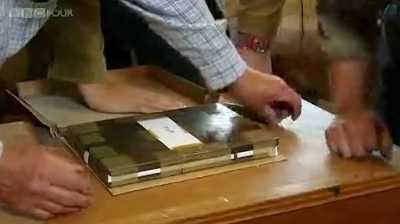
Here's the typecast-page as they remove it from the package sent by Kitty Maryatt on behalf of Scripps College in California:
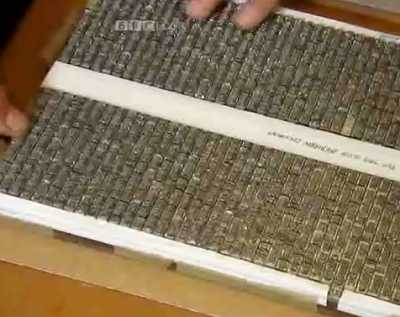
Here's a close-up of the typecast-page made in America by Kitty Maryatt & her students at Scripps College (a much better quality photo of it than I was able to take at the museum):
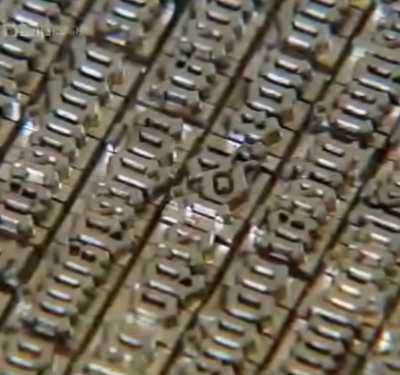
Here's Stephen Fry's guilty British fingers holding up the single version of a single European letter that he made:
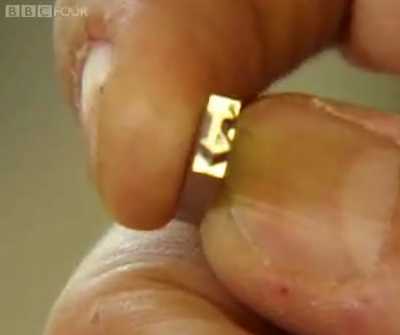
Here's Stan Nelson's innocent fingers inserting the single version of a single letter that Stephen Fry made into the middle of the entire typecast-page made in God bless America by Kitty Maryatt & her students at Scripps College:
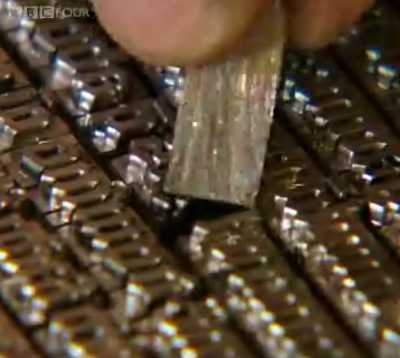
By the way, thanks to BBC Four (notice their watermark near the top-left corner of each of these lo-res screen-shots) for originally airing this film on April 14th, & for allowing me to use these screen-shots (whether they want me to or not) to give credit where credit is due.
For additional unbiased info, please refer to the film's entry in the Internet Movie DataBase.
Song of the week: "Words" by Missing Persons (click the song title to visit Amazon; click here for a 30-second sample; 394kb).
G.M. Grena
Chephirah–The Biblical Village Roars Again, 176 views
Royal Banquine, 79 views
Checkmate, 36 views

4 comments:
It look very hi-tech. A machine form by pieces.
I do appreciate your glowing commentary on the work of Kitty Maryatt's hand-setting a B-42 page, and your just comments on the thankless Brits who scripted said movie and the "lack of" credits at the film's end. Fry, in all his travels around his own Island and his trips back and forth to Germany, failed to mention the fact that even a recasting of the B-42 types were unavailable in England, Germany, Holland, France or anywhere else in Europe. Press-makers, paper-makers and foundry-type compositors are to be found in almost all European countries as well as the UK "states." The ironic fact is, that were it not for the Japanese Toppan publishers in Tokyo, and the two working members of the Dale Guild in the USA (AD 2000), all of the oohs & aahs exhaled in the movie as the sheet of paper was pulled from the form of type, would have been rather anti-climatic. The entire film would have been moot if they did not have a visual explanation of the really world changing invention of individual hand-set MOVABLE types. Without the Dale Guild's monumental efforts, they would have had the single lower-case "e" ("now that I have cast the type" -Fry) and a photo-engraving on a sheet of zinc or magnesium glued to a piece of wood. This is what almost every printing museum in the world is forced to use, including the Gutenberg Museum in Mainz to portray the 1st Printer. Imagine trying to get emotional about an impression from a sheet of zinc. Fry; "The one thing I can't wait to see is how it (the press) actually prints." Prints what?! A single type or maybe Caslon Old Face, Gill Sans or Cloister Black? It is not just we Americans that are taken for granted in the film, but the existence of foundry type in any design imaginable!
The real story is that the film makers contacted the Dale Guild with there request for a font of B-42 types "A WHOLE MONTH" before they would be shooting the "printing scene!" Type has always been taken for granted except by those making it. Fust was the first to do so, and all "producers" since, have followed in his footsteps. Anyway, we couldn't have possibly done the job in the allotted time-frame. We were busy casting a font of the typeface in question for another customer. Ms. Maryatt agreed to set the page from her existing Dale Guild B-42 font for the film makers only if we, the foundry, would promise to replace half of her 2pp font we had cast for her a year or two earlier. Had we not just begun the casting of a B-42 font for another customer, we could not have made her that promise, as it is far from profitable to cast and hand-finish a one-page font. Hence, the film-fakers -I mean- makers, would not have had their needed types in time. A serious question regarding the film's validity would have arisen in the offices of the BBC, and the reputation of the film's makers would have been tenuous at best.
Here endth but a small portion of the behind the scenery of "Stephen Fry and the Gutenberg Press."
acw
For anyone interested, The Dale Guild Type Foundry's new webpage can be found at www.thedaleguild.com
I have a double page replica produced by the museum in Mainz using the printing firm Universitats-druckerei H. Sturz AG in Wurzburg under the direction of Karl Klingspor. The museum brochure, which measures 16-1/2 X 12 inches, says the text was printed in letterpress with the initials and flourishes in offset and relief printing with genuine gold gilding...looks spectacular...any additional info?
Post a Comment